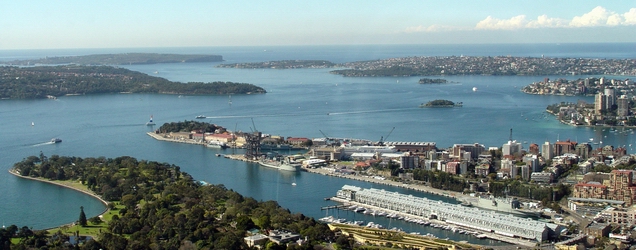
(Picture above: Sydney harbour where the first fleet from Great Britain landed in 1788))
¡@
History ---
-
Ancient heritage ---
-
Aboriginal and Torres Strait islander peoples inhabited most of the Australian continent before European settlers arrived.
-
Asian and oceanic people contacted indigenous Australians for many centuries before the Europeans came the eastern hemisphere.
-
-
European settlement
-
In March 1606, Dutch explorer Willem Janszoon (1570 - 1630) charted the west coast of Cape York Peninsula, Queensland.
-
Later in the same year, Spanish explorer Luis Vaez de Torres sailed through the strait separating Australia and Papua New Guinea.
-
In the next two centuries, European explorers and traders continued to chart the Australian coast, known as New Holland at that time.
-
In 1688, British explorer William Dampier landed on the Australian coast for the first time.
-
In 1770 another Englishman, Captain James Cook, sailed to the South Pacific and charted further Australia's east coast and claim it for the British Crown.
-
Britain sent its First Fleet of 11 ships, carrying about 1500 people¡Xhalf of them convicts, to arrive in Sydney Harbor on Jan. 26, 1788.
-
About 160,000 people were brought to Australia as convicts from 1788 until 1868. The convicts were joined by free immigrants from the early 1790s.
-
The wool industry and the gold rushes of the 1850s attracted free settlers to come to Australia.
-
-
A nation was born
-
The Commonwealth of Australia was formed in 1901 through the federation of six states under a single constitution.
-
The Commonwealth Parliament passed the Immigration Restriction Act 1901, which restricted migration to people of primarily European origin.
-
The above law of so-called "White Australia Policy" was dismantled after the Second World War.
-
-
Impact of war
-
In the First World War, almost 400 000 of them volunteered to fight in the war, and 60 000 died.
-
Every year on 25 April, Australia commemorates the brave who fought at Gallipoli, Turkey, in 1915.
-
In the Second World War Australian forces made a significant contribution to the victory in Europe, Asia and the Pacific.
-
-
Post-war prosperity
-
After the war Australia entered a boom period. Millions of refugees and migrants arrived in Australia. The economy developed strongly in the 1950s.
-
Melbourne hosted the Olympic Games of 1956, and Sydney host those of 2000.
-
In 1967 the Australian people voted in a national referendum to pass legislation on behalf of Indigenous Australians.
-
The long domination of the coalition of the Liberal and Country (now National) parties ended in 1972, when the Australian Labor Party was elected. But in 1976, Labor Prime Minister Gough Whitlam was dismissed by the Governor-General.
-
Subsequently the Liberal¡VNational Coalition ruled until 1983, when Labor won office again .
-
In 1996 a Coalition Government led by John Howard won the general election and was re-elected in 1998, 2001 and 2004.
-
Today Australia is a cosmopolitan society with more than 200 languages spoken and English being the common one.
-
Australia is still part of the British commonwealth.
-